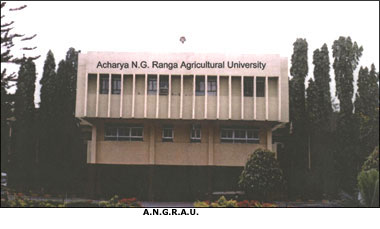![]()
ACHARYA N. G. RANGA
AGRICULTURAL UNIVERSITY
RAJENDRANAGAR,
HYDERABAD 500 030 (ANDHRA PRADESH)
Establishment
The Andhra Pradesh Agricultural University, established on 12 June 1964 under APAU Act 1963, was renamed Acharya N.G. Ranga Agricultural University with effect from 7 November 1996. Its major mandates include education, research and extension in agriculture.

Governance
The Governor of the State is the Chancellor of the university, which has Board of Management having 21 members with Vice-Chancellor as Chairman.
Infrastructure
The university has 7 teaching campuses with 13 colleges, 4 agricultural polytechnic colleges and 1 veterinary polytechnic college, 7 regional agricultural research stations, 67 research stations, extension education units, krishi vigyan kendras, extension education institute, agricultural information and communication centre and district agricultural advisory and transfer of technology centres spread all over the state. More then 5,000 personnel are employed in technical and supporting activities.
Budget
Its annual budget is around Rs 188 crores (2000-2001), 80% from the Government of Andhra Pradesh and the rest from ICAR and other agencies.
The teaching programmes (UG, PG and Ph. D.) are offered in all the major faculties Agriculture, Veterinary Science and Home Science.
Contributions
The university rank first or second in the country in several contributions.
1. It is first to introduce Rural Agricultural Work Experience Programme for B. Sc.(Agric.) students (1978-79).
2. It evolved several innovative programmes later adopted by other universities
3. Its students are generally among the top rankers in national-level entrance examinations, selections for civil services, national level NCC events and national level youth-parliament competitions
4. It released two hybrids in rice (APHR 1 and APHR 2) first in the country, next to China in the world
5. It released the first powdery mildew-resistant blackgram variety (Krishnaiah), rice varieties resistant to gallmidge (Kakatiya) and BPH (Vajram) and red-rot-resistant sugarcane (CoA 7601)
6. It released 268 improved varieties in different crops along with location-specific production and protection technologies
7. Chilli varieties released by the university have national recognition
8. About 25% (10 milliliter ha) of rice area in India is covered by the varieties released by ANGRAU, half of which by varieties Swarna, Vijetha and Cotton Dora Sannalu.
9. The castor variety Kranti released by the university has revolutionized castor production in rainfed areas of Telangana region.
10. The IPM technologies developed by the university are weaning away the farmers from excessive use of pesticides
11. Superearly dalwa technology for rice in delta area improved doruvu technology for water harvesting and use (irrigation and drinking) in coastal areas, cost-effective subsurface drainage technology, ANGRAU puddler and rice transplanter are some of the improved technologies generated and adopted on a large scale.
12. The entire breeder seed requirement of seed industry in respect of the university varieties is met by it.
13. Preservation and upgradation of world-famous Ongole breed of cattle.
14. Exploitation of embryo transfer technology in livestock improvement .
15. Fish-farming and pearl-culture technologies .
16. Release of high feed-efficient poultry strain ILR Jubilee 90.
17. Value addition to millets, low-cost technologies in reducing drudgery of farm women and improving their health and income.
18. Establishment of Daattcs
19. Distance education in agriculture
20. Rythu Mitra programme for farmers on TV (30 min. daily) and 10 minutes and on All India Radio(10 min. daily)
21. The university’s contributions are estimated to yield an annual monetary benefit of Rs 5,003 crores (1996-97) to the state.
In recognition of its accomplishments and contributions, the university was awarded ICAR Best Institution Award (1999).